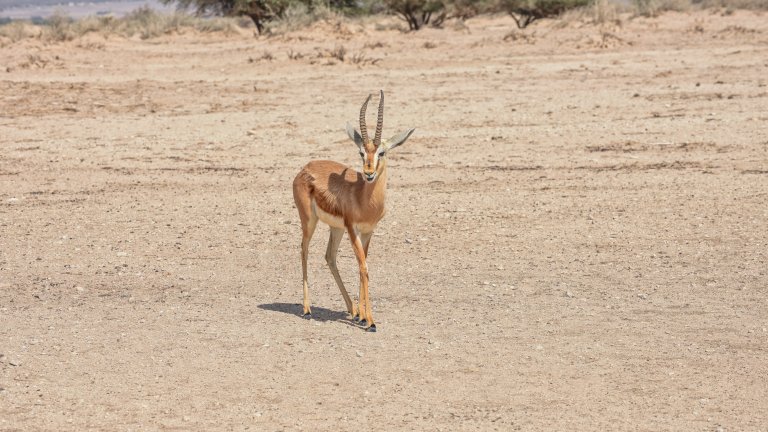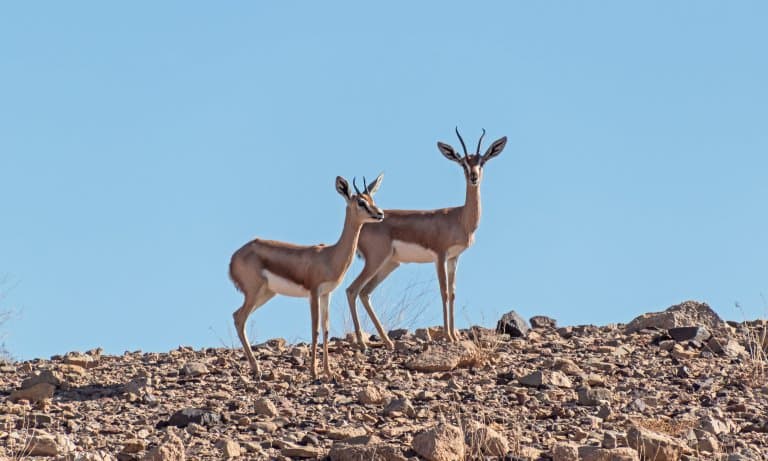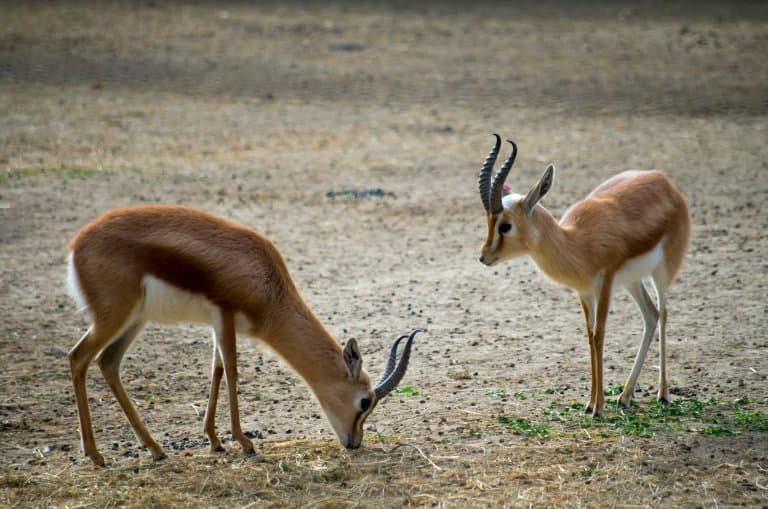Dorcas Gazelle Profile
When your primary cause of death is predation, you have to be alert at all times. And when one of your primary predators is the fastest land animal alive, you’ve got to be highly adapted to everything life throws at you.
Sometimes, having a powerful enemy is the only way to become the best version of yourself, and the Dorcas gazelle is a great example. They are a small, common gazelles that inhabit grasslands, savannas, valleys and mountain deserts in Africa and Arabia.

Dorcas Gazelle Facts Overview
| Habitat: | Grasslands, valleys, high-altitude deserts |
| Location: | North African and Arabia |
| Lifespan: | Around 12 years, 17 years in captivity |
| Size: | Around 65cm (26 inches) tall, and 90 – 110cm (3 – 3.5 ft) in body length |
| Weight: | Up to around 20kg (44lb) |
| Color: | Golden brown, with a white belly |
| Diet: | Seeds, leaves |
| Predators: | Caracals, cheetahs, wolves, leopards, jackals |
| Top Speed: | 80kmph / 50mph |
| No. of Species: |
1 |
| Conservation Status: |
Vulnerable |
Dorcas Gazelles are some of the lowest animals on the food chain, but this doesn’t mean they’re anything to sniff at.
These animals are fast and they have some incredible adaptations to the most hostile of environments on Earth. They typically live in family herds of a single male, multiple females and young. While they tend to live in smaller groups, they do congregate in large herds of up to 100 individuals.
They survive by feeding on vegetation, and will eat grasses, leaves, flowers, twigs, and fruit. Ocassionally they will stand on their hind legs to reach food on higher branches.
They can outrun almost anything, thrive in places that most mammals would struggle to live in and alter their behaviour in response to almost any threat.
Sadly, like many animals in their region, they are vulnerable to the reduction of their habitat due to humans converting it into farmland, competition with domestic animals and poaching.
Interesting Dorcas Gazelle Facts
1. They’re well adapted as a prey animal
You’d think that prey animals would have a tolerance to stress, but on the contrary, they’re very highly strung. As uncomfortable as it must be for them, anxiety keeps them alive, and being constantly on edge allows prey animals to gain an advantage over their complacent and easy-to-eat peers.
Dorcas Gazelles have quick reflexes and very sensitive eyesight that’s attuned to motion in the distance. They’ve been tagged with an ability to see a hand waving from over a kilometre away.
They’re also possibly quite rude animals; despite acknowledging the wave, there was no mention of whether they waved back. 1

2. They’re well prepared for drought
In what can only be assumed was a form of scientific torture, it was discovered that these gazelles can go 12 days without water in optimal conditions.
They are well adapted to holding onto their water by doubling the concentration of their urine and releasing as little as a quarter of their normal amount.
In Israel, individuals have been witnessed gathering enough water from Acacia leaves and bulbs, and it’s thought that in at least some populations, they don’t need to drink at all; at least, not very often.
Instead, they can extract and retain enough water from the plants they eat. 2
3. They’re one of the fastest land animals on earth
Dorcas gazelles, despite being one of the smallest antelopes, have the longest legs in proportion to their body size of any Gazelle species.
This helps them hit burst speeds rivalling that of a cheetah. Which is handy for an animal that naturally has to escape one.
In most of its modern-day habitat, the Dorcas no longer has to face big cats as they’ve all been made extinct; however, the gazelles retain the ability to move like lightning, almost as fast, and with more agility. Where speed doesn’t save them, incredible agility often does, and gazelles have this in abundance. 3
4. Both sexes have horns
Both the male and female dorcas gazelle have horns, that can have up to 25 annular rings.
While running away is their main defence, they can use them in defence, and when digging up food, such as bulbs.
They grow 25 – 38 cm (10-15.2 inches) long in males and bend sharply backwards and upwards at the tips. Females’ ridges are much thinner and straighter, with a length of 15-25 cm (6-10 inches).

5. They’ve adapted to avoid human threats, too
With their natural cat predators out of the way, you’d think the gazelles would be able to go about their business unperturbed. Unfortunately, they still have human hunters to deal with, and they have adjusted their behaviour to move around mostly at night in areas where human predation is common.
These gazelles are so versatile and well-adapted to their environment that they are able to feed at the optimal time to avoid predation, wherever they are.
In some populations, they’re nocturnal, in others, diurnal. Some are crepuscular, which is a fun word for “awake in the twilight hours”.
6. They communicate with their butts
Like many gazelles, the Dorcas has a particular wiggle.
It’s not entirely understood what this wiggle means, but gazelles seem to know exactly what’s going on when they look at what their friends’ butts are doing.
At least one type of tail wiggle in males is hypothesised to be mimicking a symbol of submission displayed by females in oestrus. If true, it would mean that this sexual display has been accommodated by all parties as a general appeasement signal; a sort of “everything’s ok” twerk.
Other functions may stem from this, including alarm signals, alertness, and high-stress environments.
We can see that there’s a lot of information being transmitted here, yet the finer details of this bovid’s buttocks still need to be teased apart.
7. They’re grumpy when they’re stressed
One way to measure stress in an animal is to record its cortisol levels. Cortisol is widely known as the “stress hormone” (though it has numerous other functions) and helps mediate the stress response.
In the wild, Dorcas gazelles have a number of social structures. Sometimes they’re wandering about in pairs, other times they have a harem or community setup. In captivity, it’s impossible to give them every option, so it’s important to make sure they’re happy with their surroundings.
Researchers found that aggressive behaviour correlates to high levels of cortisol, suggesting that when stressed, these animals tend to squabble. This is very useful information as it helps conservationists learn how to better cater for these vulnerable animals in breeding programs.

8. The males get eaten
In the wild, Dorcas gazelles have a skewed sex ratio. This is common in other gazelles species, too, though birthing rates remain relatively balanced. Something is happening to the males of the species that leads to a community with only 34% males.
That something is probably predation, as it is the males’ role to guard the group, putting them at higher risk of being caught.
This is a useful reproductive strategy, as you need far fewer males than females to breed successfully.
Coupled with their ability to move between polygynous and monogamous mating strategies in response to resource availability, they are more than capable of compensating for the skewed sex ratios. 4
9. They’re seed dispersers
As with a lot of herbivores, the dorcas gazelle plays a significant role in the breeding of plants, too.
While many of the seeds eaten by gazelles are damaged by their teeth, plenty more get through unscathed, and through some incredible ecological intricacies are actually treated to improved germination by adapting the germination of Acacia seeds to the short periods of available water; a crucial window for desert species. 5
10. Their horns are traded
Despite being a protected species under Moroccan law, their pelts and horns are traded for decoration and medicinal purposes in markets.

Dorcas Gazelle Fact-File Summary
Scientific Classification
| Kingdom: | Animalia |
| Phylum: | Chordata |
| Class: | Mammalia |
| Order: | Artiodactyla |
| Family: | Bovidae |
| Genus: | Gazella |
| Species Name: |
Gazella Dorcas |
Fact Sources & References
- “The gazelle uses both its sight and hearing to detect danger, with itssense of smell“, Course Hero.
- LAURICE I. GHOBRIAL & J. L. CLOUDSLEY-THOMPSON (1966), “Effect of Deprivation of Water on the Dorcas Gazelle“, Nature.com.
- Yoram Yom-Tov (1995), “Gazella dorcas“, The American Society of Mammalogists.
- GRETTENBERGER, J. (1987), “Ecology of the dorcas gazelle in northern Niger“, SciHub.
- Gideon Halevy (2013), “EFFECTS OF GAZELLES AND SEED BEETLES (BRUCHIDAE) ON GERMINATION AND ESTABLISHMENT OF ACACIA SPECIES“, Israel Journal of Botany.
